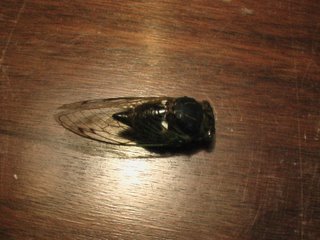Got Cicada Killers? Science in the backyard.
While digging up the weed bed in my backyard, that in previous years has been a vegetable garden, I happened to unearth a large fresh cicada with no earth on it nor any sign of dehydration. Though the nymphs of cicadas do live underground they emerge from the earth and climb a tree to molt and become adults. A quick look around confirmed that cicadas had recently been molting in my back yard.  (Exoskeleton of cicada nymph after molting) I was curious how a fully developed cicada happened to be underground in my garden, but kept digging so that I could plant some Swiss Chard and Turnips in time for cool weather. As I continued digging, something buzzed past me.  It was a large hornet-like insect that I immediately recognized as a cicada killer wasp. So I grabbed my video camera and snapped some pictures and video figuring I had the makings of a Tangled Bank/Circus of the Spineless post. If you're not familiar with cicada killers they're a very interesting critter and you can learn more about them here than all but the most dedicated cicada killer enthusiasts could possibly need to know. The astute reader has probably discerned that, as the name suggests, cicada killers kill cicadas. The adult cicada killer lives on nectar and pollen from flowers so they don't eat the cicadas themselves, their offspring do. Female cicada killers hunt by methodically searching deciduous trees for their prey. Once spotted, the female stings the cicada paralyzing it, she grasps the cicada to her underbelly with her legs and then she flies or crawls back to her burrow. In the burrow the cicada killer places the incapacitated cicada into an individual cell and lays either a male or female egg on the cicada.   Interestingly, cicada killers provide their larger female offspring with two or more cicadas while males only rate one. So, somehow the cicada killer is able to control whether its offspring are male or female, probably by controlling whether stored sperm are allowed to fertilize her egg. (Male wasps are haploid so they only need genetic material from the mother so no sperm would be necessary.) After placing the cicadas in the cell the female blocks off the entry to the cell and leaves the burrow to hunt for more cicadas. After the eggs hatch the larvae consume the anesthetized cicada, molt several times as they grow, then form a cocoon in which to overwinter and undergo metamorphosis to emerge the following summer just as their cicada prey are also emerging.  Do you have cicadas in your yard or near wher you live? As it turns out you can help with cicada killer research if you do. These researchers are collecting cicada killers and the cicadas they prey on from all over the country. They have a list of each county that they still need specimens from so that they can identify the range of different types of cicada killers and which cicada species they prey upon. You can either kill and mail in your cicada killer (they recommend swatting them to the ground with a tennis racket and finishing them off with finger nail polish in a glass jar) or you can take a digital picture and email it to them. I've emailed them to let them know that I'm standing by with camera in one hand, raquetball racket in the other to help them out if they need me! So if you have a cicada killer burrow near you get in touch with them and see if you can help out. UPDATE: The latest edition of the Tangled Bank is up at Hairy Museum of Natural History. UPDATE: Submitted to the Friday Ark. The only blog inspired by a Bumper Sticker. |









